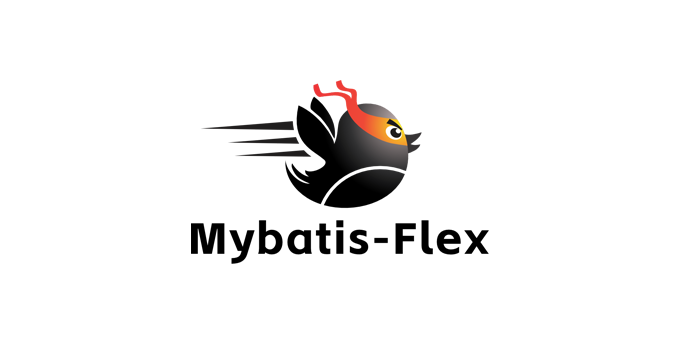MyBatis-Flex v1.4.7 发布,新增 4 个关联查询注解
MyBatis-Flex: 一个优雅的 MyBatis 增强框架
特征
1、很轻量
MyBatis-Flex 整个框架只依赖 MyBatis,再无其他任何第三方依赖。
2、只增强
MyBatis-Flex 支持 CRUD、分页查询、多表查询、批量操作,但不丢失 MyBatis 原有的任何功能。
3、高性能
MyBatis-Flex 采用独特的技术架构、相比同类框架(比如 MyBatis-Plus),MyBatis-Flex 的在增删改查等方面的性能均超越其 5~10 倍或以上。
4、更灵动
MyBatis-Flex 支持多主键、多表查询、逻辑删除、乐观锁、数据脱敏、数据加密、多数据源、分库分表、字段权限、 字段加密、多租户、事务管理、SQL 审计... 等等等等。 这一切,免费且灵动。
MyBatis-Flex v1.4.7 主要是新增了 4 个关联查询注解,他们分别是:
- RelationOneToOne:用于一对一的场景
- RelationOneToMany:用于一对多的场景
- RelationManyToOne:用于多对一的场景
- RelationManyToMany:用于多对多的场景
一对一 @RelationOneToOne
假设有一个账户,账户有身份证,账户和身份证的关系是一对一的关系,代码如下所示:
Account.java :
public class Account implements Serializable {
@Id(keyType = KeyType.Auto)
private Long id;
private String userName;
@RelationOneToOne(selfField = "id", targetField = "accountId")
private IDCard idCard;
//getter setter
}
IDCard.java :
@Table(value = "tb_idcard")
public class IDCard implements Serializable {
private Long accountId;
private String cardNo;
private String content;
//getter setter
}
@RelationOneToOne 配置描述:
- selfField 当前实体类的属性
- targetField 目标对象的关系实体类的属性
PS: 若 selfField 是主键,且当前表只有 1 个主键时,可以不填写。
假设数据库 5 条 Account 数据,然后进行查询:
List<Account> accounts = accountMapper.selectAllWithRelations();
System.out.println(accounts);
其执行的 SQL 如下:
SELECT `id`, `user_name`, `age` FROM `tb_account`
SELECT `account_id`, `card_no`, `content` FROM `tb_idcard`
WHERE account_id IN (1, 2, 3, 4, 5)
查询打印的结果如下:
[
Account{id=1, userName='孙悟空', age=18, idCard=IDCard{accountId=1, cardNo='0001', content='内容1'}},
Account{id=2, userName='猪八戒', age=19, idCard=IDCard{accountId=2, cardNo='0002', content='内容2'}},
Account{id=3, userName='沙和尚', age=19, idCard=IDCard{accountId=3, cardNo='0003', content='内容3'}},
Account{id=4, userName='六耳猕猴', age=19, idCard=IDCard{accountId=4, cardNo='0004', content='内容4'}},
Account{id=5, userName='王麻子叔叔', age=19, idCard=IDCard{accountId=5, cardNo='0005', content='内容5'}}
]
一对多 @RelationOneToMany
假设一个账户有很多本书籍,一本书只能归属一个账户所有;账户和书籍的关系是一对多的关系,代码如下:
Account.java :
public class Account implements Serializable {
@Id(keyType = KeyType.Auto)
private Long id;
private String userName;
@RelationOneToMany(selfField = "id", targetField = "accountId")
private List<Book> books;
//getter setter
}
Book.java :
@Table(value = "tb_book")
public class Book implements Serializable {
@Id(keyType = KeyType.Auto)
private Long id;
private Long accountId;
private String title;
//getter setter
}
@RelationOneToMany 配置描述:
- selfField 当前实体类的属性
- targetField 目标对象的关系实体类的属性
PS: 若 selfField 是主键,且当前表只有 1 个主键时,可以不填写。
假设数据库 5 条 Account 数据,然后进行查询:
List<Account> accounts = accountMapper.selectAllWithRelations();
System.out.println(accounts);
其执行的 SQL 如下:
SELECT `id`, `user_name`, `age` FROM `tb_account`
SELECT `id`, `account_id`, `title`, `content` FROM `tb_book`
WHERE account_id IN (1, 2, 3, 4, 5)
多对一 @RelationManyToOne
假设一个账户有很多本书籍,一本书只能归属一个账户所有;账户和书籍的关系是一对多的关系,书籍和账户的关系为多对一的关系,代码如下:
Account.java 一对多的配置:
public class Account implements Serializable {
@Id(keyType = KeyType.Auto)
private Long id;
private String userName;
@RelationOneToMany(selfField = "id", targetField = "accountId")
private List<Book> books;
//getter setter
}
Book.java 多对一的配置:
@Table(value = "tb_book")
public class Book implements Serializable {
@Id(keyType = KeyType.Auto)
private Long id;
private Long accountId;
private String title;
@RelationManyToOne(selfField = "accountId", targetField = "id")
private Account account;
//getter setter
}
@RelationManyToOne 配置描述:
- selfField 当前实体类的属性
- targetField 目标对象的关系实体类的属性
PS: 若 targetField 目标对象的是主键,且目标对象的表只有 1 个主键时,可以不填写。
多对多 @RelationManyToOne
假设一个账户可以有多个角色,一个角色也可以有多个账户,他们是多对多的关系,需要通过中间件表 tb_role_mapping 来维护:
tb_role_mapping 的表结构如下:
CREATE TABLE `tb_role_mapping`
(
`account_id` INTEGER ,
`role_id` INTEGER
);
Account.java 多对多的配置:
public class Account implements Serializable {
@Id(keyType = KeyType.Auto)
private Long id;
private String userName;
@RelationManyToMany(
joinTable = "tb_role_mapping", // 中间表
selfField = "id", joinSelfColumn = "account_id",
targetField = "id", joinTargetColumn = "role_id"
)
private List<Role> roles;
//getter setter
}
Role.java 多对多的配置:
@Table(value = "tb_role")
public class Role implements Serializable {
private Long id;
private String name;
@RelationManyToMany(
joinTable = "tb_role_mapping",
selfField = "id", joinSelfColumn = "role_id",
targetField = "id", joinTargetColumn = "account_id"
)
private List<Account> accounts;
//getter setter
}
@RelationManyToMany 配置描述:
- selfField 当前实体类的属性
- targetField 目标对象的关系实体类的属性
- joinTable 中间表
- joinSelfColumn 当前表和中间表的关系字段
- joinTargetColumn 目标表和中间表的关系字段
注意:selfField 和 targetField 配置的是类的属性名,joinSelfColumn 和 joinTargetColumn 配置的是中间表的字段名。
若 selfField 和 targetField 分别是两张关系表的主键,且表只有 1 个主键时,可以不填写。
父子关系查询
比如在一些系统中,比如菜单会有一些父子关系,例如菜单表如下:
CREATE TABLE `tb_menu`
(
`id` INTEGER auto_increment,
`parent_id` INTEGER,
`name` VARCHAR(100)
);
Menu.java 定义如下:
@Table(value = "tb_menu")
public class Menu implements Serializable {
private Long id;
private Long parentId;
private String name;
@RelationManyToOne(selfField = "parentId", targetField = "id")
private Menu parent;
@RelationOneToMany(selfField = "id", targetField = "parentId")
private List<Menu> children;
//getter setter
}
查询顶级菜单:
QueryWrapper qw = QueryWrapper.create();
qw.where(MENU.PARENT_ID.eq(0));
List<Menu> menus = menuMapper.selectListWithRelationsByQuery(qw);
System.out.println(JSON.toJSONString(menus));
SQL 执行如下:
SELECT `id`, `parent_id`, `name` FROM `tb_menu` WHERE `parent_id` = 0
SELECT `id`, `parent_id`, `name` FROM `tb_menu` WHERE id = 0
SELECT `id`, `parent_id`, `name` FROM `tb_menu` WHERE parent_id IN (1, 2, 3)
JSON 输出内容如下:
[
{
"children": [
{
"id": 4,
"name": "子菜单",
"parentId": 1
},
{
"id": 5,
"name": "子菜单",
"parentId": 1
}
],
"id": 1,
"name": "顶级菜单1",
"parentId": 0
},
{
"children": [],
"id": 2,
"name": "顶级菜单2",
"parentId": 0
},
{
"children": [
{
"id": 6,
"name": "子菜单",
"parentId": 3
},
{
"id": 7,
"name": "子菜单",
"parentId": 3
},
{
"id": 8,
"name": "子菜单",
"parentId": 3
}
],
"id": 3,
"name": "顶级菜单3",
"parentId": 0
}
]
MyBatis-Flex v1.4.7 更新如下:
- 新增:
@RelationManyToMany@RelationManyToOne@RelationOneToMany@RelationOneToOne4 个注解用于关联查询 - 新增:为 QueryMethods 添加更多的 SQL 函数重载,感谢 @王帅
- 新增:代码生成器添加 @Mapper 主键的启用配置,感谢 @王帅
- 新增:BaseMapper 添加 selectRowsByQuery() 方法
- 优化:重构 selectCountByQuery 方法,移除不必要的实现类,感谢 @王帅
- 优化:重构 TableInfo.buildResultMap(),防止在某些极端情况出现赋值错误的问题
- 修复:代码生成器 ControllerGenerator 的 OverwriteEnable 配置不生效的问题
- 文档:添加关于 QueryMethods 的一些用法和示例,感谢 @王帅
- 文档:修改 apt 配置错误的问题,感谢 @王帅
- 文档:添加关于 sql 函数的一些函数说明
- 文档:添加关于关联查询注解的相关文档
进一步了解 MyBatis-Flex 框架,请参考一下链接:
- 1、快速开始:https://mybatis-flex.com/zh/intro/getting-started.html
- 2、多表关联查询:https://mybatis-flex.com/zh/base/query.html
- 3、一对多、多对一:https://mybatis-flex.com/zh/base/field-query.html
- 4、灵活的 QueryWrapper:https://mybatis-flex.com/zh/base/querywrapper.html
- 5、逻辑删除:https://mybatis-flex.com/zh/core/logic-delete.html
- 6、乐观锁:https://mybatis-flex.com/zh/core/version.html
- 7、数据填充:https://mybatis-flex.com/zh/core/fill.html
- 6、数据脱敏:https://mybatis-flex.com/zh/core/mask.html
- 7、SQL 审计:https://mybatis-flex.com/zh/core/audit.html
- 8、多数据源:https://mybatis-flex.com/zh/core/multi-datasource.htm
- 9、数据源加密:https://mybatis-flex.com/zh/core/datasource-encryption.html
- 10、动态表名:https://mybatis-flex.com/zh/core/dynamic-table.html
- 11、事务管理:https://mybatis-flex.com/zh/core/tx.html
- 12、数据权限:https://mybatis-flex.com/zh/core/data-permission.html
- 13、字段权限:https://mybatis-flex.com/zh/core/columns-permission.html
- 14、字段加密:https://mybatis-flex.com/zh/core/columns-encrypt.html
- 15、字典回写:https://mybatis-flex.com/zh/core/columns-dict.html
- 16、枚举属性:https://mybatis-flex.com/zh/core/enum-property.html
- 17、多租户:https://mybatis-flex.com/zh/core/multi-tenancy.html
- 18、代码生成器:https://mybatis-flex.com/zh/others/codegen.html
- 19、QQ 交流群:https://mybatis-flex.com/zh/intro/qq-group.html
- 20、更好用的功能正在路上:https://mybatis-flex.com
和其他框架对比请参考:
- 1、和
MyBatis-Plus、Fluent-Mybatis【功能】方面的对比:https://mybatis-flex.com/zh/intro/comparison.html - 2、和
MyBatis-Plus【性能】方面的对比:https://mybatis-flex.com/zh/intro/benchmark.html





